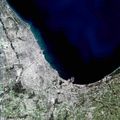Demographics
As of the 2020 census [2] there were 6,655 people, 1,427 households, and 1,258 families residing in the township. The population density was 189.66 inhabitants per square mile (73.23/km2). There were 1,966 housing units at an average density of 56.03 per square mile (21.63/km2). The racial makeup of the township was 66.10% White, 11.04% African American, 0.89% Native American, 2.00% Asian, 0.00% Pacific Islander, 7.63% from other races, and 12.34% from two or more races. Hispanic or Latino of any race were 22.13% of the population.
There were 1,427 households, out of which 61.60% had children under the age of 18 living with them, 73.72% were married couples living together, 11.07% had a female householder with no spouse present, and 11.84% were non-families. 11.80% of all households were made up of individuals, and 0.80% had someone living alone who was 65 years of age or older. The average household size was 3.36 and the average family size was 3.62.
The township's age distribution consisted of 32.1% under the age of 18, 7.2% from 18 to 24, 29.9% from 25 to 44, 27.4% from 45 to 64, and 3.3% who were 65 years of age or older. The median age was 33.2 years. For every 100 females, there were 84.6 males. For every 100 females age 18 and over, there were 103.1 males.
The median income for a household in the township was $94,037, and the median income for a family was $100,032. Males had a median income of $56,472 versus $39,570 for females. The per capita income for the township was $34,548. About 0.0% of families and 1.0% of the population were below the poverty line, including 0.0% of those under age 18 and 0.0% of those age 65 or over.
Historical population| Census | Pop. | Note | %± |
|---|
| 2000 | 846 | | — |
|---|
| 2010 | 4,455 | | 426.6% |
|---|
| 2020 | 6,655 | | 49.4% |
|---|
|
This page is based on this
Wikipedia article Text is available under the
CC BY-SA 4.0 license; additional terms may apply.
Images, videos and audio are available under their respective licenses.


